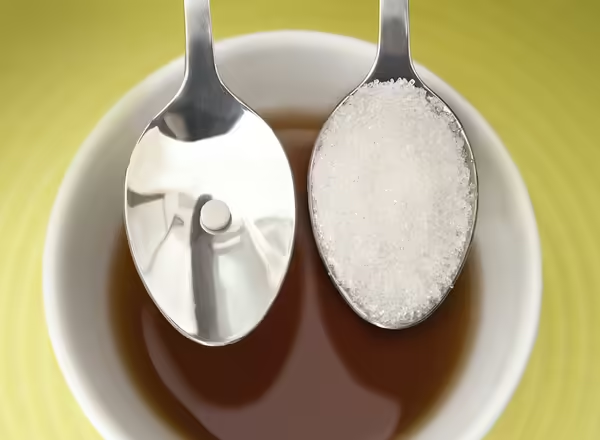
Artificial Sweeteners and Diabetes
What are Artificial or Non-nutritive Sweeteners?
Artificial or non-nutritive sweeteners are sweeteners that do not provide any carbohydrate or calories per serving. There are five main non-nutritive sweeteners:
Acesulfame K (potassium)
Sold as Sweet One® or Sunett, it has less of an aftertaste than saccharin and it is more stable when heated than aspartame. This sweetener, however, it is not available in all markets. The Acceptable Daily Intake is 15 mg/kg body weight/day, according to the FDA.
Aspartame
Sold as NutraSweet and Equal, has little aftertaste but becomes unstable at high temperatures so it is not appropriate for baking or cooking. Advantame is a sweetener mad from aspartame and isovanillin. The Acceptable Daily Intake is 50 mg/kg body weight/day, according to the FDA.
Neotame
Although it has been approved for use by the FDA in 2002, it is not available for individual use. The Acceptable Daily Intake is 0.3 mg/kg body weight/day, according to the FDA.
Saccharin
Sold as Sweet n Low®, Sweet Twin, Necta Sweet, or as Sugar Twin®, this sweetener is very stable for baking, but it does have a noticeable aftertaste when used in large quantities. The Acceptable Daily Intake is 15 mg/kg body weight/day, according to the FDA.
Stevia
Truvia™, Sweetleaf, and PureVia™ are brand name table-top zero calorie sweeteners that are also used as an ingredient in some beverages. Truvia™ can be found in some Coca-Cola products and PureVia™ can be found in some PepsiCo. products. The sweetening ingredient, rebiana is found in the leaves of the stevia plant. There are many forms of rebiana compounds. There is not a specified Acceptable Daily Intake value.
Sucralose
With the trade name of Splenda®, it is an artificial sweetener that is made from sugar with certain chemical changes. It has the same volume and taste as sugar and it is stable to heat. Using large amounts of Splenda® will add calories. For this reason, products made with Splenda® will have fewer calories than if made with sugar but will still have some added sweetener calories. The Acceptable Daily Intake is 5 mg/kg body weight/day, according to the FDA.
Note: Sugar Twin sold in Canada contains cyclamate, which is banned in the United States.

Many people would like to use artificial sweeteners, but avoid them because they fear that they may be unsafe. Saccharin, aspartame, acesulfame potassium, and sucralose underwent years of testing before manufacturers were permitted to add them to foods.
They have each been determined by the Food and Drug Administration (FDA) to be safe for use by almost all people. The FDA also recognizes two additional sweeteners, stevia (Truvia™ and PureVia™) and luo han guo extract as generally safe.
The exception is for those very rare people who are born with a condition called phenylketonuria (PKU). These people cannot metabolize foods that contain large amounts of phenylalanine, one of the ingredients in aspartame. People with this condition must avoid aspartame and many other high-protein foods. Certain other people may report headaches or other symptoms after eating foods containing artificial sweeteners. These people should also avoid the artificial sweeteners since they are not a required part of the diet.

- Diet carbonated beverages
- Diet or low calorie candy
- Diet or low calorie cookies
- Diet or low calorie pudding and gelatin
- Low calorie yogurt
- Sugar-free canned fruit
- Sugar-free chewing gum
Check the ingredient list of any low calorie or diet food before you purchase it.